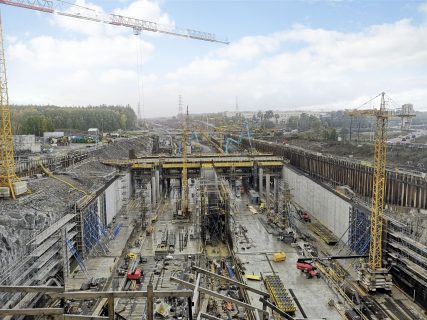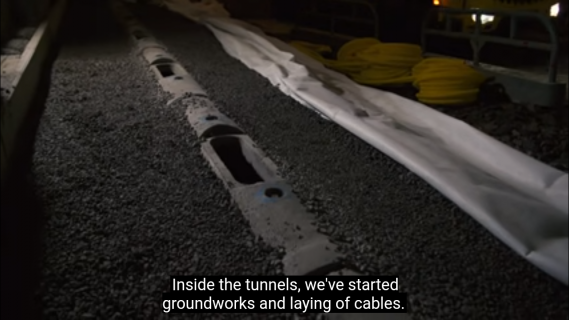Tunnels cover 18km of the 21km of the Stockholm’s E4 Bypass mega-project. If it goes as planned, it will take 15 years from its commencement to opening in 2030. Stockholm is one of the fast growing urban in Europe. The Swedish city region’s 14 islands are home to over 2.1 million people,expected to grow to around 2.5 million by 2030. For a better urban development, good infrastructure is important. The city entered service in 2017 for a 7.4km Stockholm City Line, or Citybanan, which is an electrified double-track commuter route with two stations.
Although the City line represents a vital step to a better public transport, it hasn’t reached the level to control increasing vehicle traffic in the city. Stockholm only has only one main thoroughfare, Essingeleden, which was constructed in 1967 when the country switched to the right-hand side driving. It was the first six-lane motorway in the country, designed for 80,000 daily vehicles per day of which nowadays 160,000 vehicles use it on a typical working day.
In the 1990s, Essingeleden was redeveloped to eight lanes to ease congestion. The motorists on Essingeleden have been subject to a congestion charge from 2016. Nonetheless, traffic on the highway remains too vulnerable to disruption by road accidents. Due to the situation, a 21km motorway bypass is being developed to link the city’s south Skärholmen with Häggvik which is in the north. The new way,the Stockholm’s E4 Bypass mega-project, will divert traffic away from the city centre towards the west.
Stockholm’s E4 Bypass mega-project
The E4 Bypass , “E4 Förbifart Stockholm” in Swedish is one of the country’s largest infrastructure projects. After completion in 2030, it will run between the Kungens Kurva (King’s Curve) and the Häggvik interchange.
Of the Stockholm’s E4 Bypass mega-project 21km, fully 18km will run through tunnels, fitting in the list of world’s longest urban road tunnels. A slight shorter than Tokyo’s Yamate Tunnel which runs over 18km. Six interchanges will be developed to join the tunnel system with the existing roads along the tunnel’s route.

It will include twin tunnels with a 70m below sea level point being the deepest and beneath Lake Mälaren. Three lanes will be developed on both tunnels, increasing to four at the six new interchanges in the route. Around 22 million tonnes of rock is being excavated for the construction.
Read also:Second River Niger Bridge project timeline and all you need to know
Project timeline.
In 2009 the Swedish government approved the project and the development was expected to commence in 2010, running for a period of eight years . The Stockholm’s E4 Bypass mega-project total cost was estimated at US$3.3 billion. However, the project didn’t commence until 2014 with tunnel excavation starting in 2016. Estimated period to completion is a decade and at an elevated cost of $4.11 billion.
2019
Worksite safety issues in 2019 led to the cancellation of a contract for one part of the tunnel. The completion period has been reviewed, with 2030 most likely being its opening, with the cost rising to nearly $4.5 billion.
2021
In June 2021, the project was in its most intense phase with construction taking place along the whole stretch. The project is done in various phases with building phase followed by installations and testing. The team have excavated 75% of the rock at the building phase. They get to installation phase after assembling and testing technical equipments.

At Kungen Kurva, they were on concrete work for walls, supporting walls and noise barrier. The tunnel was set to open for pedestrians and cyclists in the summer. Between Skarholmen and Kungens Kurva, they had separated the wider tunnel and the lanes for pedestrians and cyclists. All the tunnelling between Skarholmen and Kungshatt had completed, with the fitting work ongoing. After that, the next phase of installation of technical systems was to start.
The rebuilding of Ekerovsgen between Nockeby and Tappstrom had started along the whole route with construction entering the heritage site of Drottningholm where reinforcement was taking place. The new tunnel at Lindo had been blasted but the work on technical installation had remained. The new tunnel for traffic towards Ekero will have two lanes and be 148M long.

In Vinsta, they had a simultaneous work on relaying pipes, groundworks and the concrete works for the tunnel that will join Beryslagsvagen with the main tunnel on E4 forbifart Stockholm. Between Hasselby and lake malaren, tunnel work continued. Nearly all the rocks had been blasted between Vinsta and Hjulsta and finished work on the main bridges edge beams.

At Akalla junction they had restored the surface with construction coming to an end and installation work for fans, ventilations and signalling starting. At the start of summer, they did major traffic diversion in Haggvik, moving the road on three phases to easier the job without disrupting access on the E4.
Doka is part of the many major sub-contractors and is tasked with providing formwork equipment for four of the project’s sections. Their products include Framax Xlife and Framax Xlife Plus systems accompanied with large-area formwork Top 50, load-bearing tower Staxo 40 and Staxo 100, as well as the formwork traveller and the heavy-duty supporting system SL-1

Leave a Reply